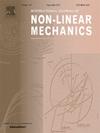A non-linear thermoelastic constitutive model for isotropic materials based on Gibbs free energy
IF 3.2
3区 工程技术
Q2 MECHANICS
International Journal of Non-Linear Mechanics
Pub Date : 2025-10-04
DOI:10.1016/j.ijnonlinmec.2025.105274
引用次数: 0
Abstract
This paper presents a Gibbs free energy-based constitutive framework for large thermoelastic deformations of isotropic materials. The independent constitutive variables are the Kirchhoff stress tensor and the temperature, while the dependent variables are the spatial logarithmic Hencky strain tensor and the entropy. The approach relies on the multiplicative decomposition of the deformation gradient, which naturally leads to an additive decomposition of the Hencky strain into uncoupled deviatoric, volumetric, and thermal parts. The Gibbs potential is likewise additively decomposed into elastic and thermal parts. The elastic part of the Gibbs free energy per unit intermediate volume can be taken as any of the complementary energy potentials developed for isothermal, non-linear elastic deformations, with the additional assumption that the material coefficients are temperature-dependent. The thermal part of the Gibbs free energy depends on the spherical component of the Kirchhoff stress tensor and the temperature. General forms of the constitutive equations for the Hencky strain and entropy are derived for compressible materials. In the case of incompressible materials, the inherently implicit constitutive model yields explicit relations between the Hencky strain and Cauchy stress components. Special forms of the thermoelastic constitutive equations are derived and investigated for two cases: (i) a modified Hencky-type model suitable for moderately large strains, and (ii) a power-law form of the elastic Gibbs free energy expressed in terms of stress invariants. The predictive capabilities of these models, particularly with respect to the thermoelastic inversion effect and structural heating in rubber-like materials, are evaluated through parameter fitting to experimental data. Comparisons are also made with predictions from a thermoelastic extension of Ogden’s constitutive model.
基于吉布斯自由能的各向同性材料非线性热弹性本构模型
提出了一种适用于各向同性材料大热弹性变形的吉布斯自由能本构框架。独立本构变量为基尔霍夫应力张量和温度,因变量为空间对数亨奇应变张量和熵。该方法依赖于变形梯度的乘法分解,这自然导致henky应变的加性分解为不耦合的偏差、体积和热部分。吉布斯势也同样相加分解为弹性和热两个部分。单位中间体积的吉布斯自由能的弹性部分可以作为等温非线性弹性变形的任何互补能势,并附加假设材料系数与温度相关。吉布斯自由能的热部分取决于基尔霍夫应力张量的球分量和温度。导出了可压缩材料的henky应变和熵本构方程的一般形式。在不可压缩材料的情况下,固有的隐式本构模型产生了亨基应变和柯西应力分量之间的显式关系。本文推导并研究了两种情况下热弹性本构方程的特殊形式:(i)适用于中等大应变的修正henky型模型,以及(ii)弹性Gibbs自由能的幂律形式,即应力不变量。通过对实验数据的参数拟合来评估这些模型的预测能力,特别是关于橡胶类材料的热弹性反转效应和结构加热。还与奥格登本构模型的热弹性扩展预测进行了比较。
本文章由计算机程序翻译,如有差异,请以英文原文为准。
求助全文
约1分钟内获得全文
求助全文
来源期刊
CiteScore
5.50
自引率
9.40%
发文量
192
审稿时长
67 days
期刊介绍:
The International Journal of Non-Linear Mechanics provides a specific medium for dissemination of high-quality research results in the various areas of theoretical, applied, and experimental mechanics of solids, fluids, structures, and systems where the phenomena are inherently non-linear.
The journal brings together original results in non-linear problems in elasticity, plasticity, dynamics, vibrations, wave-propagation, rheology, fluid-structure interaction systems, stability, biomechanics, micro- and nano-structures, materials, metamaterials, and in other diverse areas.
Papers may be analytical, computational or experimental in nature. Treatments of non-linear differential equations wherein solutions and properties of solutions are emphasized but physical aspects are not adequately relevant, will not be considered for possible publication. Both deterministic and stochastic approaches are fostered. Contributions pertaining to both established and emerging fields are encouraged.

 求助内容:
求助内容: 应助结果提醒方式:
应助结果提醒方式:


